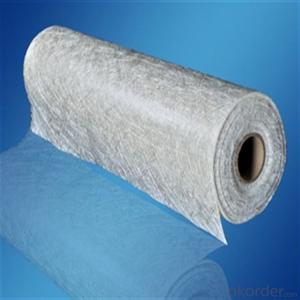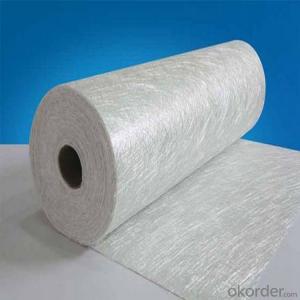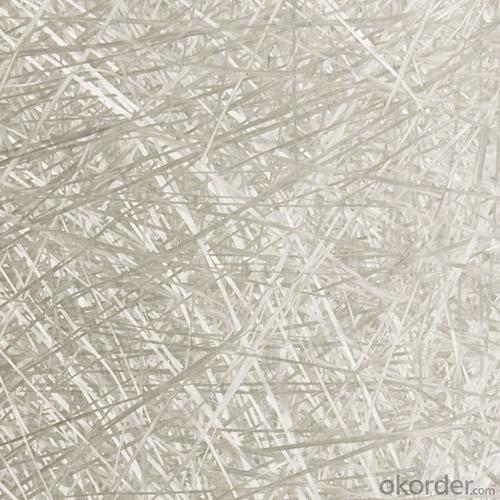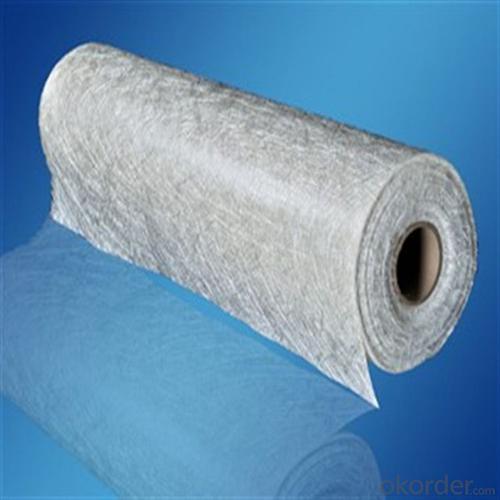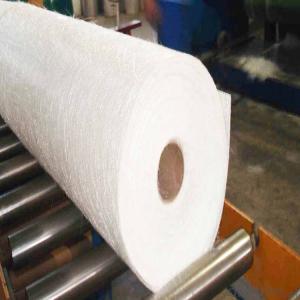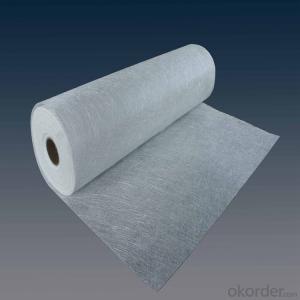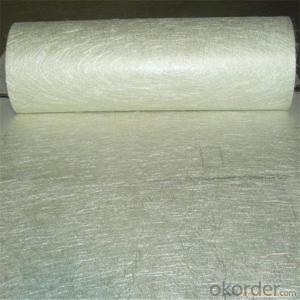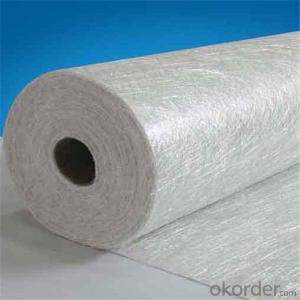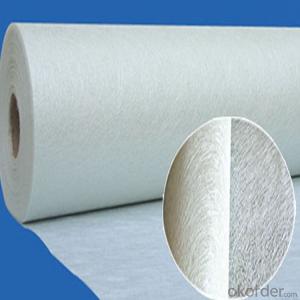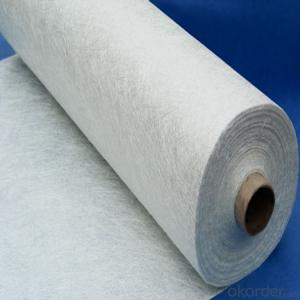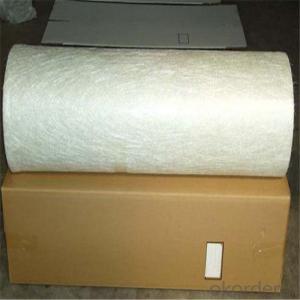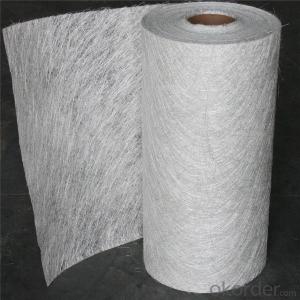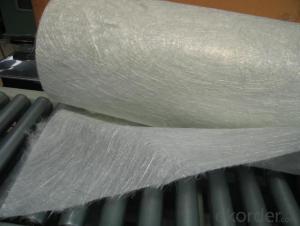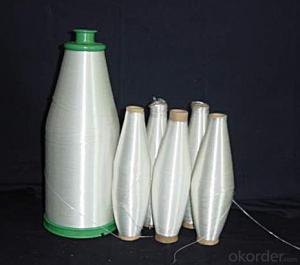Chopped Strand Fiberglass Mat (CSM) Technique and E-Glass Fiberglass Type chopped strand mat
- Loading Port:
- China main port
- Payment Terms:
- TT OR LC
- Min Order Qty:
- 1 kg
- Supply Capability:
- 10000 kg/month
OKorder Service Pledge
OKorder Financial Service
You Might Also Like
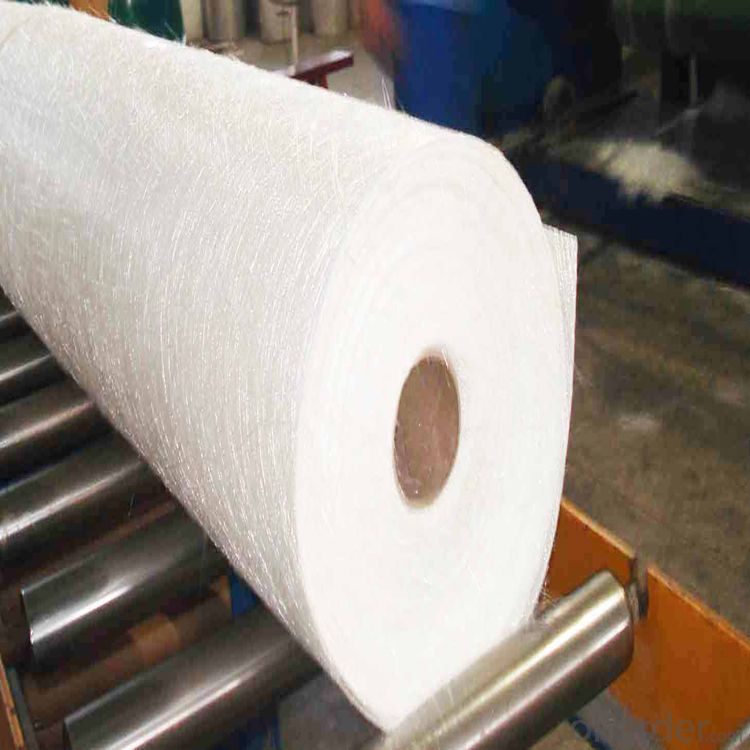
Product Description:
Fiberglass Chopped Strand Mat is fine strand reinforcement material made from E-glass cut fibers laid in a random pattern and bonded with powder or emulsion binder.
It is easy to handle and has excellent moulding performance.
Also, it has rapid resin penetration together with a fast strand wet out time.
The mat also brings a highly translucent finished laminates.
Also,the fine strand input makes the fiber prominence at the finished laminates surface extremely low.
Features
1.Excellent weight uniformity
2.Fast wet out
3.Easy air release
4.Excellent transparency of finished products
5.Excellent laminate
6.Low resin consumption
Application
1.Translucent roof panel
2.chemical storage tanks
3.FRP pipes
4.Boat hulls
5.Decks
6.Truck body panel
7.Cooling towers
8.Corrosion resistand
Specifications:
Item | Over Density | Moisture Content | Chop Density | Polyester Yarn | Width |
(g/m2) | (%) | (g/m2) | (g/m2) | (mm) | |
EMK300 | 309.5 | ≤0.15 | 300 | 9.5 | 50-3300 |
EMK380 | 399 | 380 | 19 | ||
EMK450 | 459.5 | 450 | 9.5 | ||
EMK450 | 469 | 450 | 19 | ||
EMC0020 | 620.9 | 601.9 | 19 | ||
EMC0030 | 909.5 | 900 | 9.5 |
Special products are available according to customer’s requirement.
Product Packaging:
Each Surface Tissue is wound onto a paper tube which has an inside diameter of 76mm and the mat roll has a diameter of 330mm. The mat roll is wrapped up with plastic film,and then packed in a cardboard box or wrapped up with kraft paper. The rolls can be vertically or horizontally placed. For transportation, the rolls can be loaded into a cantainer directly or on pallets.
Quantity
20'GP Container:About 10000kgs
40'HP Container:Aboout 23100kgs
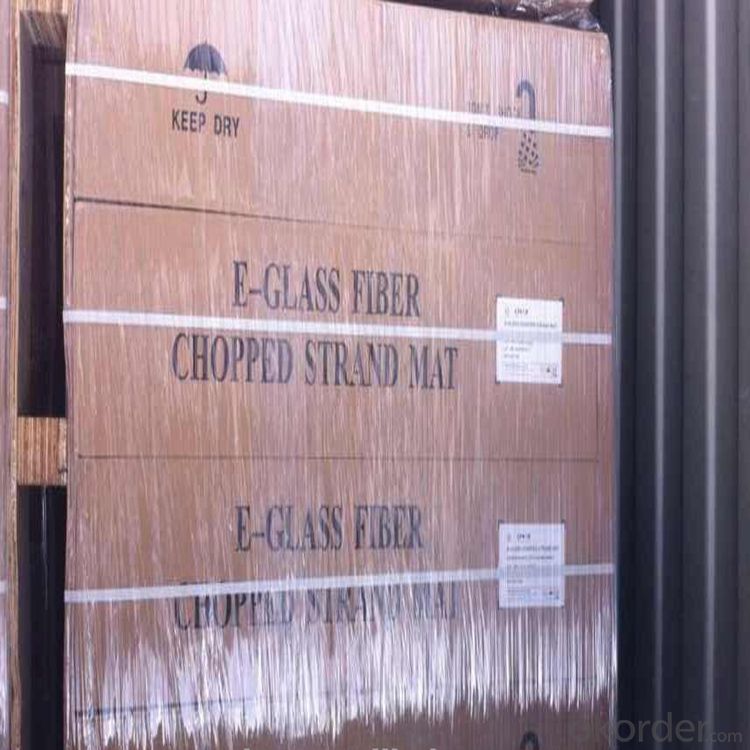
Product Storage:
Unless otherwise specified, Chopped Strand Mat should be stored in a dry, cool and rain-proof area. It is recommended that the room temperature and humidity should be always maintained at 15℃~35℃ and 50%~75% respectively.
Company Information
CNBM (China National Building Material) Group is the largest comprehensive building materials group in China that in integrate scientific research, manufacturing and logistics into one entity. The largest building materials and equipment specialists in China. Upon State Council approval, today CNBM owned more than 300 subordinate manufacturing factories and servicing companies. There are 6 fully owned public listed companies and 11 partially owned with substantial shares public listed companies. In many of these fields, CNBM is playing the leading role in the building industry in the country.

Our Service:
1.Any inquiry will be replied within 24 hours.
2.Professional manufacturer.
1) Print logo in the products;
2) The size and specification can be produce and design according to your demand.
3.High quality,fashion designs,reasonable and competitive price,fast lead time.
4.After-sale service
1) All products will have been strictly quality check in house before packing.
2) All products will be well packed before shipping.
3) All our products have 10 years rot resistance.
5.Faster delivery:sample order in stock,and 15-20 days for bulk production.
6.Payment:you can pay for the order via:T/T,Western Union,MoneyGram,L/C etc.
FAQ:
which kind of glass fiber sample and materials can you provide?
We can provide the glass fiber and glass fiber down stream products samples of E glass, C glass, ECR glass, High alkali glass. The products includes single end roving, assembled roving for different applications( Piping, SMC, panel, winding mill plate) , chop strand for BMC, engineering plastic (PA, PPA, PPT, POM, etc), chop strand mat (from 100gsm-900gsm) for automobile and water tank, etc, woven roving (270gsm-800gsm), surface tissue (25-50gsm), multi-axial fabric of different unit weight.
- Q: Can fiberglass chopped strand be used in composite materials?
- Yes, fiberglass chopped strand can be used in composite materials. Fiberglass chopped strand consists of small, randomly chopped fibers made from glass. These fibers are typically mixed with a resin to create a composite material. The chopped strands provide reinforcement to the composite, enhancing its strength and durability. The use of fiberglass chopped strand in composites is common in various industries, including automotive, aerospace, construction, and marine. It is an effective and cost-efficient way to add strength and stiffness to composite materials, making them suitable for a wide range of applications.
- Q: Is fiberglass chopped strand compatible with different manufacturing processes?
- Fiberglass chopped strand is indeed compatible with various manufacturing processes. It is a highly adaptable material that finds utility in diverse manufacturing techniques, including compression molding, injection molding, and filament winding. It can be combined with different resins, such as polyester, epoxy, and vinyl ester, resulting in composite materials with a wide range of properties. The incorporation of chopped strand into these processes is a seamless process, ensuring both effective dispersion and reinforcement throughout the final product. Moreover, the usage of fiberglass chopped strand in sheet molding compounds (SMCs) and bulk molding compounds (BMCs) allows for the production of parts that are both lightweight and possess exceptional strength. Consequently, fiberglass chopped strand boasts remarkable flexibility and compatibility with various manufacturing processes, rendering it a highly sought-after choice within industries such as automotive, aerospace, construction, and marine.
- Q: Can fiberglass chopped strand be used in aerospace interior components?
- Fiberglass chopped strand is indeed applicable for aerospace interior components. This lightweight and versatile material possesses exceptional strength and durability, making it widely utilized across various industries, including aerospace. The aerospace sector demands interior components that are both lightweight and capable of withstanding the rigorous conditions of flight. Fiberglass chopped strand fulfills these requirements, as it is lightweight and boasts high tensile strength. It finds extensive use in the production of panels, seat backs, overhead bins, and cabin partitions. Notably, fiberglass chopped strand exhibits exceptional fire resistance properties, which are of utmost importance in aerospace applications. It successfully adheres to the stringent fire safety regulations and standards set by aviation authorities. Moreover, the processing of fiberglass chopped strand is relatively straightforward, ensuring efficient and cost-effective manufacturing processes. It can be molded into diverse shapes and sizes, making it ideal for intricate aerospace interior designs. In summary, fiberglass chopped strand is an ideal material for aerospace interior components due to its lightweight nature, high strength, fire resistance, and ease of processing. Its utilization in the aerospace industry contributes to the safety, performance, and comfort of both passengers and crew members during flights.
- Q: What are the moisture resistance properties of fiberglass chopped strand?
- Fiberglass chopped strand has excellent moisture resistance properties. This is due to its composition, which typically includes a combination of glass fibers and a resin matrix. The glass fibers are inherently resistant to moisture, preventing any absorption or degradation of the material. Additionally, the resin matrix used in fiberglass chopped strand is usually water-resistant, providing an extra layer of protection against moisture penetration. This combination of moisture-resistant components makes fiberglass chopped strand highly durable and suitable for various applications in wet or humid environments. It is often used in the construction industry for applications such as roofing, insulation, and water tanks, where exposure to moisture is common. Overall, the moisture resistance properties of fiberglass chopped strand make it a reliable and long-lasting material in environments where moisture can potentially cause damage or degradation.
- Q: Does fiberglass chopped strand have any health hazards?
- Fiberglass chopped strand presents potential health hazards if safety precautions are not properly observed. The primary concern lies in the emission of fiberglass particles into the atmosphere, which can be inhaled and result in respiratory issues. These particles are extremely fine and can cause irritation to the skin, eyes, and lungs if adequate protective gear is not utilized. Prolonged exposure to fiberglass particles has been associated with health issues such as lung cancer, mesothelioma, and various respiratory diseases. It is important to note that the likelihood of developing these conditions is generally higher for individuals who regularly work with fiberglass, such as those in the manufacturing or construction industries. To mitigate the health risks associated with fiberglass chopped strand, it is advised to wear protective clothing, gloves, goggles, and a respirator when handling or being in proximity to fiberglass. Proper ventilation and containment measures should also be implemented to prevent the release of particles into the air. Regular cleaning and maintenance of work areas are crucial in minimizing the accumulation of fiberglass dust and debris. In conclusion, although fiberglass chopped strand does possess health hazards, these risks can be minimized by adhering to appropriate safety protocols and utilizing suitable protective equipment.
- Q: Is fiberglass chopped strand suitable for the production of automotive components?
- Automotive components can be produced using fiberglass chopped strand, a reinforcement material commonly found in composite materials. This particular material possesses numerous advantages that render it appropriate for automotive applications. To begin with, fiberglass chopped strand exhibits exceptional strength and stiffness properties, both of which are crucial for withstanding a variety of loads and vibrations. It boasts a high tensile strength, which enhances the structural integrity of components, thus making it an ideal option for automotive manufacturers. Secondly, fiberglass chopped strand is lightweight, a highly desirable characteristic for automotive applications where reducing the overall weight of the vehicle takes precedence. The utilization of lightweight materials can contribute to improved fuel efficiency and vehicle performance. Furthermore, fiberglass chopped strand displays excellent resistance against corrosion, chemicals, and temperature fluctuations, making it suitable for automotive components exposed to harsh environments. Additionally, it offers commendable electrical insulation properties, a beneficial feature for components requiring electrical conductivity or insulation. What's more, fiberglass chopped strand proves to be cost-effective in comparison to materials such as carbon fiber, while still delivering satisfactory mechanical properties. This affordability makes it an appealing choice for automotive manufacturers seeking to strike a balance between performance and cost. In conclusion, fiberglass chopped strand stands as a fitting material for automotive component production due to its strength, lightweight nature, resistance to corrosion, and cost-effectiveness. These properties establish it as a reliable choice for various applications within the automotive industry.
- Q: Is fiberglass chopped strand lightweight?
- Yes, fiberglass chopped strand is lightweight. Chopped strand refers to short fibers of fiberglass that have been cut to a specific length. These fibers are typically mixed with a resin or binder to form a composite material. Since fiberglass itself is a lightweight material, the chopped strands retain this characteristic. This makes fiberglass chopped strand an ideal choice for applications that require a lightweight material, such as automotive parts, boat hulls, and aerospace components. Additionally, the lightweight nature of fiberglass chopped strand allows for increased flexibility and ease of handling during the manufacturing process.
- Q: Is fiberglass chopped strand resistant to heat?
- Generally, fiberglass chopped strand exhibits resistance to heat. It is composed of glass fibers and a thermosetting resin, typically polyester or epoxy. These constituents possess a high melting point and can endure elevated temperatures without melting or distorting. Nevertheless, it is crucial to acknowledge that the heat resistance of fiberglass may fluctuate depending on the particular type and composition of the material. Certain fiberglass items are engineered to withstand higher temperatures compared to others. It is highly advised to consult the manufacturer's specifications and guidelines for the particular fiberglass chopped strand product to ascertain its heat resistance capabilities.
- Q: Does fiberglass chopped strand improve the fatigue resistance of composite materials?
- Yes, fiberglass chopped strand can improve the fatigue resistance of composite materials. Fiberglass is known for its high strength and stiffness, and when added as chopped strands to a composite matrix, it reinforces the material and enhances its ability to withstand cyclic loading and fatigue. The random orientation of the chopped strands helps to distribute the stress throughout the composite, reducing the likelihood of crack initiation and propagation. The high tensile strength of fiberglass chopped strand also helps to resist the propagation of cracks, thereby increasing the fatigue life of the composite material. This reinforcement effect is especially important in applications where the composite material is subjected to repeated loading or vibrations, such as in the aerospace, automotive, and sporting goods industries. In addition, the unique properties of fiberglass, such as its resistance to moisture and chemicals, further contribute to the enhanced fatigue resistance of the composite material. By preventing moisture ingress and chemical attack, fiberglass chopped strand helps to preserve the structural integrity of the composite and prolong its fatigue life. It is worth noting that the specific design and composition of the composite material, including the type and amount of fiberglass chopped strand used, as well as the matrix material, can influence the extent of improvement in fatigue resistance. Therefore, careful consideration and testing should be conducted to optimize the composite formulation for the desired fatigue performance.
- Q: What are the fatigue strength properties of fiberglass chopped strand?
- The ability of fiberglass chopped strand to endure repeated loading and unloading cycles without failing or deteriorating is what is referred to as its fatigue strength properties. Fiberglass chopped strand is commonly utilized in different fields where durability and resistance to fatigue are crucial, such as the automotive industry, construction, and marine applications. Several factors influence the fatigue strength of fiberglass chopped strand, including the quality of the resin matrix used to bind the strands, the length and orientation of the strands, and the overall quality of the manufacturing process. When manufactured and processed correctly, fiberglass chopped strand can display excellent fatigue strength properties. Fiberglass chopped strand typically exhibits a long fatigue life, allowing it to endure thousands or even millions of loading cycles without failing. This is because of the inherent properties of fiberglass, such as its high tensile strength and stiffness, which effectively distribute and absorb stress throughout the material. Moreover, the orientation of the chopped strands significantly impacts the fatigue strength properties. When the strands are randomly oriented, the fatigue resistance may be lower compared to aligned or continuous fibers. Nonetheless, the use of advanced manufacturing techniques, like controlled fiber alignment or weaving, can enhance the fatigue strength properties of fiberglass chopped strand. It's important to consider that various external factors, such as temperature fluctuations, exposure to chemicals, and environmental conditions, can influence the fatigue strength of fiberglass chopped strand. These factors can potentially degrade the material over time, reducing its fatigue resistance. In conclusion, fiberglass chopped strand is renowned for its excellent fatigue strength properties when properly manufactured and processed. It provides a durable and reliable material choice for applications that require resistance to cyclic loading, making it a popular option in industries where fatigue resistance is essential.
Send your message to us
Chopped Strand Fiberglass Mat (CSM) Technique and E-Glass Fiberglass Type chopped strand mat
- Loading Port:
- China main port
- Payment Terms:
- TT OR LC
- Min Order Qty:
- 1 kg
- Supply Capability:
- 10000 kg/month
OKorder Service Pledge
OKorder Financial Service
Similar products
Hot products
Hot Searches
Related keywords

